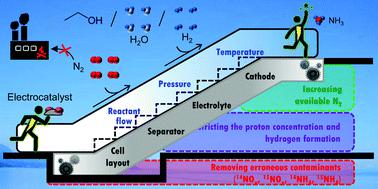当前位置:
X-MOL 学术
›
Energy Environ. Sci.
›
论文详情
Our official English website, www.x-mol.net, welcomes your
feedback! (Note: you will need to create a separate account there.)
Strategies in cell design and operation for the electrosynthesis of ammonia: status and prospects
Energy & Environmental Science ( IF 32.4 ) Pub Date : 2022-05-11 , DOI: 10.1039/d2ee00953f Wei Bi 1 , Nima Shaigan 2 , Ali Malek 2 , Khalid Fatih 2 , Előd Gyenge 1 , David P. Wilkinson 1
Energy & Environmental Science ( IF 32.4 ) Pub Date : 2022-05-11 , DOI: 10.1039/d2ee00953f Wei Bi 1 , Nima Shaigan 2 , Ali Malek 2 , Khalid Fatih 2 , Előd Gyenge 1 , David P. Wilkinson 1
Affiliation

|
Ammonia (NH3) electrosynthesis directly from nitrogen at ambient temperature and pressure is a thermodynamically feasible yet a kinetically challenging route to address the energy and environmental concerns associated with the well-established Haber–Bosch process. Despite growing interest and progress boosted by innovative electrocatalyst development, this emerging field is still plagued by insufficient catalytic activities and low faradaic efficiencies to reach commercial relevance. Electrolytic cell design and operational conditions are two overlooked aspects, which offer important approaches along with advanced electrocatalysts to produce NH3. This work provides a thorough and critical overview of a large number of published electrocatalysis results highlighting the analytical uncertainties associated with N-containing contaminants. Furthermore, it systematically summarizes the electrochemical cell designs, the choices of cell components, and key operational parameters for NH3 electrosynthesis. Strategies to promote nitrogen mass transfer while controlling the proton access near reaction sites are highlighted, which include using gas-phase reactors, selecting a suitable membrane/electrolyte configuration, engineering the electrode's (electro)chemical and physical properties, and adjusting the operating conditions and flow configurations under kinetic and mass transfer limitation considerations.
中文翻译:

电合成氨的电池设计和操作策略:现状和前景
在环境温度和压力下直接从氮气中电合成氨 (NH 3 ) 在热力学上是可行的,但在动力学上具有挑战性,可以解决与成熟的 Haber-Bosch 工艺相关的能源和环境问题。尽管创新的电催化剂开发推动了越来越多的兴趣和进步,但这一新兴领域仍然受到催化活性不足和法拉第效率低以达到商业相关性的困扰。电解池设计和操作条件是两个被忽视的方面,它们提供了重要的方法以及先进的电催化剂来生产 NH 3. 这项工作对大量已发表的电催化结果进行了全面而批判性的概述,突出了与含氮污染物相关的分析不确定性。此外,它系统地总结了电化学电池的设计、电池组件的选择以及NH 3电合成的关键操作参数。强调了在控制反应位点附近的质子进入的同时促进氮传质的策略,包括使用气相反应器、选择合适的膜/电解质配置、设计电极的(电)化学和物理特性,以及调整操作条件和在动力学和传质限制考虑下的流动配置。
更新日期:2022-05-11
中文翻译:

电合成氨的电池设计和操作策略:现状和前景
在环境温度和压力下直接从氮气中电合成氨 (NH 3 ) 在热力学上是可行的,但在动力学上具有挑战性,可以解决与成熟的 Haber-Bosch 工艺相关的能源和环境问题。尽管创新的电催化剂开发推动了越来越多的兴趣和进步,但这一新兴领域仍然受到催化活性不足和法拉第效率低以达到商业相关性的困扰。电解池设计和操作条件是两个被忽视的方面,它们提供了重要的方法以及先进的电催化剂来生产 NH 3. 这项工作对大量已发表的电催化结果进行了全面而批判性的概述,突出了与含氮污染物相关的分析不确定性。此外,它系统地总结了电化学电池的设计、电池组件的选择以及NH 3电合成的关键操作参数。强调了在控制反应位点附近的质子进入的同时促进氮传质的策略,包括使用气相反应器、选择合适的膜/电解质配置、设计电极的(电)化学和物理特性,以及调整操作条件和在动力学和传质限制考虑下的流动配置。









































 京公网安备 11010802027423号
京公网安备 11010802027423号